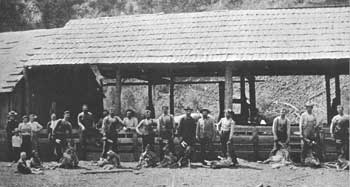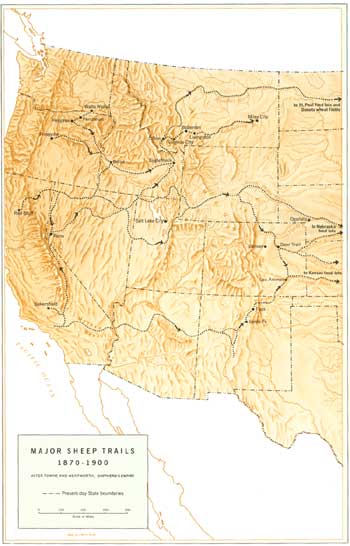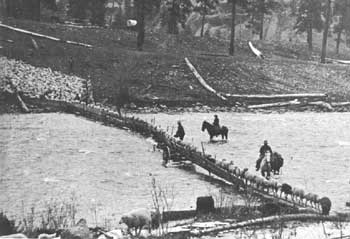






Historical Background
"Woolies" and "Wars"
Less renowned in story and song and less romantic in its appeal to the public than the cattle industry, the sheep industry was nevertheless of considerable economic importance in the historic West. During the post-Civil War period, it too struggled for a place in the Western sun. Sheepmen used the cattlemen's range and in many ways operated on the same basic principles—utilizing the grass and water of the public domain and depending on trail drives to reach markets.
 |
| Sheep have always figured prominently in the economy of the West. The sheepman led a lonely life and faced the violent antagonism of the cattlemen. Photograph by Lee Moorhouse. (Courtesy, Photographic Bureau, University of Oregon.) |
The Spaniards introduced sheep into present California, Arizona, New Mexico, and Texas, usually in the mission establishments. In 1779 the Hopi pueblos probably grazed 30,000 sheep, and one California mission reported 100,000 in its herd. But New Mexico was the leading center. Between 1821 and 1846 its herders drove thousands of head annually to Mexico. The year after the United States acquired the Southwest in 1848, the California gold rush furnished a new market. In the 1850's half a million head moved from New Mexico Territory to the Mother Lode country, which paid fabulous prices until California ranches could satisfy the demand. Soon thousands of sheep landed in Pacific ports to stock California ranches. Many California counties grazed from 40,000 to 300,000 head, and some ranchers drove sheep to other States or Territories. After 1853 California ranchers found a ready wool market in San Francisco.
By 1865 New Mexican shepherds were grazing their sheep in eastern Colorado Territory, which was soon dotted with herds. In 1876, by which time sheep raising had spread to other parts of the Territory, the total number ran into the hundreds of thousands. New Mexicans also drove the first sheep into Utah from the south, and Mormons drove them in from the east. Mormon immigrants brought in spinning wheels, looms, and cards; and woolen manufacture thrived. In 1882, 10 woolen mills were operating. During the 1880's Texas assumed a position of first importance in sheep husbandry. In 1884 more than 8 million sheep grazed its ranges. Sheep ranching occurred on a smaller scale in Montana, Idaho, Wyoming, the Dakotas, Washington, and Oregon. These States had no large ranches, but many small stockmen raised sheep.
 |
| Migrants assisted at shearing time. Like harvest hands, they followed the season north from the Southwest into the Rocky Mountains and Canada. (Courtesy, Photographic Bureau, University of Oregon.) |
The sheep industry prospered because hungry easterners showed the same inclination after the Civil War to pay high prices for mutton that they did for beef. Also the sheepmen had the additional bonus of high prices for their wool. As they spread out over the West in search of new grazing lands for their flocks, they came into conflict with the cattlemen. In the eyes of the cowboy the sheep man was low on the human scale. A person who stooped to eat mutton, according to the cowpunchers, was known to have degenerate tendencies. The fact that dogs were used to herd sheep and that the herder walked, rather than rode a horse like a man, only added to the cowboy's scorn. The cattleman's contempt for the lowly sheep and the humble herder only served to heighten his rage when he encountered the despised "woolies" contentedly grazing on the grass he claimed by right of prior use—if not by the "natural" priority of cattle over sheep.
According to cattlemen, sheep had a gland between the two halves of their hooves that secreted a foul-smelling fluid. They claimed that cattle would not graze on grass contaminated with this scent. The cattle were really not quite so sensitive. In fact they would graze side by side in the same pasture with sheep. But the hostility between cattlemen and sheepmen intensified. Perhaps the real cause of the cattlemen's hatred was the growing scarcity of grass. The "woolies" were extremely destructive to a range—especially to one that was overstocked. They industriously cropped the grass down to the roots, and their sharp little hooves destroyed the roots.
Attempts by sheepmen to find grazing lands were usually met with violence and the sheep driven from the range. Murders of shepherds and the slaughter of their flocks were not uncommon. In the Tonto Basin of Arizona a bloody range war broke out. During 5 years of hostilities, which degenerated into a feud between two families, every law-abiding rancher left the region and more than 30 cattlemen and sheepmen died. In Wyoming, along the Green River, the introduction of sheep likewise led to violence. Masked cattlemen attacked four sheep camps during the night, tied the herders up, and clubbed nearly 8,000 of the hated "woolies" to death.
 |
| Major sheep trails, 1870-1900 (click on image for an enlargement in a new window) |
In a country ruled by cattlemen the sheepmen received little protection from the law. The sheepmen quickly discovered that, though the meek might inherit the earth, if they carried loaded 30-30's, shot first, and then talked humbly, they and their sheep stood a better chance of living to collect the inheritance.
 |
| Sheep, like cattle, were driven to markets or railheads. When streams barred the way, sheep required special bridges. Specially trained wethers or goats led the crossings. (Courtesy, Photographic Bureau, University of Oregon.) |
The sheepmen, in common with the ranchers, had the problem of getting their animals to railheads or markets. The sheep drives began, as did the cattle drives, shortly after the Civil War. Most of the sheep, in herds numbering as many as 7,500, were trailed eastward from California and Oregon, some to the Rocky Mountain mining camps, but most to the feedlots and railheads of Kansas, Nebraska, and Minnesota (St. Paul). As the railroads moved westward, the trails grew shorter.
The number of "woolies" trailed eastward during the period from 1865 to 1900 was about 15 million. Many difficulties were involved in the driving of sheep such great distances, over mountains and deserts and through the domain of hostile cattlemen. Yet the success of these drives guaranteed the ascendancy of the West over the East in sheep husbandry—a decisive influence on the economy of the trans-Mississippi country.
 |
 |
http://www.cr.nps.gov/history/online_books/prospector-cowhand-sodbuster/intro5.htm
Last Updated: 22-May-2005